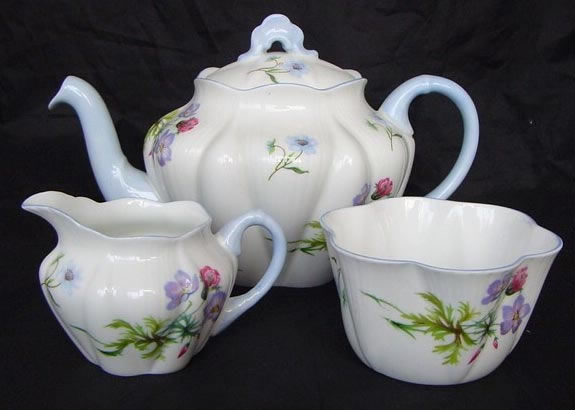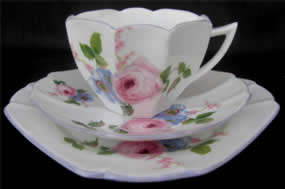Shelley Seconds Ware: Too Good to Pass Up
 by Carolyn Keating
by Carolyn Keating
Table of Contents
Too Good to Pass Up
This ongoing project hopes to provide pictures of all 571 Seconds ware patterns listed in Chris Davenport’s book Shelley Pottery: The Later Years as an identification aid for collectors. Few Seconds ware patterns have been pictured in the numerous books written about Shelley, yet the patterns are lovely and worthwhile for the collector. In particular the range of floral patterns produced from 1935 onwards are especially appealing to North American tastes and should not be overlooked in one’s collection. Chris’s book lists all Seconds patterns numbered from 2000 to 2571 which Shelley produced from June 1919 until June 24, 1966 when Shelley was sold to Allied English Potteries. Prior to June 1919 Seconds patterns were listed in the Best Ware pattern books along with Best Ware.
According to Chris, “Seconds ware came about because a fault was found at the white ware stage of manufacture. White ware was produced when the pottery had been fired once (biscuit ware), dipped in glaze and refired. It was at this point that the fault was found during inspection and the ware was stored until the decision to use it was taken.” Chris and Ray Reynolds, former Decorating Manager for Shelley Potteries, described the types of faults which led to ware being designated as Seconds thusly: “A piece could be slightly misshapen, i.e., a twist in a saucer or plate, or a cup not fully round, or the handle slightly to one side. There could be a glaze blob on the piece, (where the glaze had not run properly), a glaze nip, usually on a foot of a cup where a small piece of glaze has stuck, or pinholes in the glaze.” These faults are often covered by the litho on the finished piece so that a collector may not be able to discover the fault. Anything with a crack or chip would have been thrown out. These Seconds ware pieces were sold by Shelley at a deep discount. Shelley took great pride in the quality of their wares and would never have sold ware with hidden faults at full price.
The Table of Seconds Ware Patterns provides a pictorial view of as many patterns as are currently known, along with an Appendix of Shapes that lists all shapes which have been seen for each pattern. These include: Ascot, Avon, Bute, Bristol Coffee, Cambridge, Canterbury, Carlisle, Carlton, Chester, Court, Dainty, Doric, Dorothy, Ely, Empire, Eve, Footed Dainty, Footed Oleander, Gainsborough, Georgian, Henley, Kenneth, Lomond, Ludlow, Milton, Mocha, Mode, Norman, New Mocha, New York, Oleander, Ovide, Oxford, Perth, Princess, Queen Anne, Regent, Richmond, Ripon, Savoy, Stirling, Strand, Stratford, Scandinavian Coffee, Tall Dainty, Victoria, Vincent, Vogue, Warwick, Windsor and York. For the name of the pattern and a full description, the collector is directed to Chris’ book, which also lists the shapes for each pattern as stated in the Shelley pattern books. As many collectors know, the pattern books are not an exhaustive list of all shapes that a pattern was produced on, so the Appendix of Shapes provides a list of all the additional shapes for each pattern which have been discovered thus far.
Not all pattern numbers have yet been identified. There are several reasons for this: Shelley may not have produced some of the patterns or in such low quantities that little has survived; and many of the Seconds ware pieces were not stamped with a pattern number (remember that Shelley was trying to produce these pieces economically for quick sale and the addition of pattern numbers was an extra cost). So the pictures which appear in this Table show only those pieces which have been discovered with a pattern number on the bottom. The collector may be able to identify an unmarked piece from this Table of pictures. To date, the Table includes over four hundred of the patterns from 2000-2571. The early patterns dating from 1919-1930 are the most elusive and are under-represented in the Table.
Shelley Pottery purchased lithographs from many different companies in England and the continent. These lithographers are referred to in both the pattern books and in Chris’s book. The companies are: Ratauds, Commercial, Cappers, Baileys, Mulder and Zoon, German, Hulmes, Butchers, Johnson Matthey, Hitching, Chromo, Davies, Enterprise, Warwick Savage, Universal and Goors. Susan Hill in her book The Shelley Style has explained that “these were predominately lithographs with limited or no handpainting involved. Such patterns were usually discontinued when the original quantity of lithographs had been exhausted.” This is yet another reason why some Seconds ware patterns seem to be very hard to find.
Sometimes the lithographs used on Seconds Ware are the same ones used on Best Ware, but the finishes are less detailed and less costly. If one examines a Seconds Ware cup and saucer closely, one may not be able to discover any defect. That is because the lithograph may completely disguise the defect. Given the beauty of the lithographs found on Seconds ware, it is easy to see why collectors today are willing to pay the same or higher prices than are paid for Best Ware. It is all in the rarity of the pattern and the beauty in the eye of the beholder.
When attempting to identify an unnumbered pattern, the collector should look carefully at the color of the handle, and the rim and foot of the cup. Various Seconds ware patterns differ only slightly in the handle, edge and footline. One example is German FLORAL SPRAYS. Pattern 2348 has a green handle and foot, and green trim on the cup rim and edge of the saucer; 2355 has a green handle, but gold trim on the cup and saucer; and 2361 has a gold handle and gold trim.
Seconds ware patterns were put onto many different types of ware: cups and saucers, small plates, dinner plates, flat cake plates, pedestal cake plates, sandwich plates, butter pats, teapots, coffeepots, gravy boats, covered vegetable dishes, creamers and sugars, sweet dishes, tennis sets, platters, large bowls, lemonade pitchers, beakers, cream soups, covered muffin dishes, jam jars, cigarette holders, and covered sugar bowls. Occasionally an entire coffee set has been discovered. Chris Davenport has published pictures of coffee sets in his book and the reader is directed to pages 193-232. Even a dinner set has been seen , but this is rare.
This research has been ongoing for many years, yet many patterns remain unidentified. If the reader has a photo of one of the missing patterns and would like to help in this project, please forward photos of the piece and backstamp with pattern number to [email protected]. Any additional information would also be appreciated. Since this project first appeared on the NSCC website, many collectors from around the world have written to offer photos of missing patterns. All this help is gratefully acknowledged and much appreciated.
Table of Seconds Ware Patterns
To view all the pictures in the Table, please click on the picture below:
Appendix of Seconds Ware Shapes
This Appendix contains all Seconds Ware patterns which have been discovered, in addition to those contained in the pattern books. All pattern numbers and shapes which have been seen are noted in bold.
References
Davenport, Chris, Shelley Pottery: The Later Years, Heather Publications Ltd., Congleton, Cheshire, UK: 1997.
Hill, Susan, The Shelley Style, Jazz Publications Limited, Stratford Upon Avon, Warwickshire, UK: 1990.
